Approaching Comet C/2012 S1 "ISON"
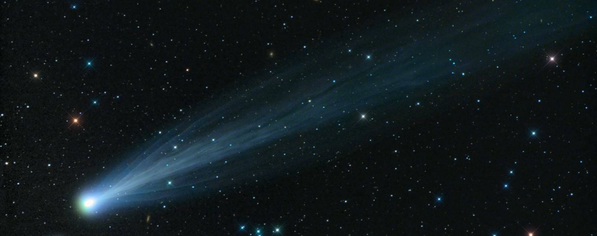
November 28, 2013
T -0 D-day! Comet ISON vs The Sun
Most of you have already seen latest ISON images from SOHO's LASCO and are sharing this unique experience with the rest of the world. If you are not in the train yet… we are all watching ISON via space-based solar observatories, following updates on social networks and none of us knows what will happen next. It is really a unique experience if you are into this kind of thing.
Quick recap of yesterday's events: ISON climbed tremendously in brightness but this can't offer us any evidence at all as to whether it will survive or not. General consensus was that ISON is behaving like a sungrazer. "It means that ISON is now in a very near-Sun region of the solar system and is experiencing levels of solar radiation that your average comet is never going to have to deal with. Accordingly, its surface is boiling away furiously, releasing tremendous amounts of ice, dust and gas and brightening up enormously." – Karl Battams, CIOC.
If ISON does survive, it will probably become visible to experienced amateur astronomers by December 2 or 3.
We've had this cosmic mystery hovering over us since September of last year, and now, at last, we are on the verge of getting an answer. This will not be a scientific discovery that happens behind closed doors, or announced in a stuffy scientific paper that most people won't read. This months-long astronomical cliffhanger is about to reach its conclusion, and will do so live, online, in realtime, for the whole world to see. I hope that everyone appreciates the truly extraordinary nature of this event, regardless of outcome, and I hope that everyone enjoys it as much as us scientists are going to! – Karl Battams, CIOC.
Important note:
After today, this article will not be updated with latest Comet ISON news. For latest updates go here:
Comet ISON vs The Sun – Perihelion – near-real time coverage
or skip to:
Comet ISON – Timeline of events and best images since its discovery
November 27, 2013
T -1 Brightening dramatically
Latest CIOC update with LASCO C3 imagery :
Now that we have observations of the comet in the NASA STEREO instruments and, more recently, the ESA/NASA SOHO LASCO C3 instrument, CIOC team member Matthew Knight has been able to start recording photometry of the comet. His results seem to imply that the comet may have experienced an outburst during the (approximate) period Nov 21 – 23 with corresponding brightness increase, followed by a leveling off and then dropping back down to "pre-outburst" levels. Since entering the LASCO C3 field of view, comet ISON has increased by at least a factor of four, and indications are it may be closer to a factor of ten. In the most recently available images, the comet appears to be around magnitude +0.5.
It is now the opinion of the CIOC Team that Comet ISON is now behaving like a sungrazing comet. We can not comment on whether the nucleus is in tact or not, but our analyses indicate that its rate of brightening is directly in line with that we have experienced with other sungrazing comets. This has no implication on its chances of survival. We strongly encourage all professional solar observatories who have plans in place for observing the comet, to please do so, and the teams should plan for an object brighter than negative one magnitude (and we are being conservative on this estimate).
Today's tl;dr is somewhat upbeat: we don't know if ISON will survive, and we won't know until it either does it or vaporizes. But the comet is still "alive" and brightening dramatically in accordance with the behavior we expect of sungrazers. Professional observers with solar telescopes should plan for a negative magnitude object, and we urge observation from these facilities.
CRITICALLY IMPORTANT: Comet ISON is extremely close to the Sun and you should NOT attempt to observe it in binoculars or telescope unless you are highly experienced in making these observations. Sunlight through magnifying optics can and WILL permanently damage eyesight.
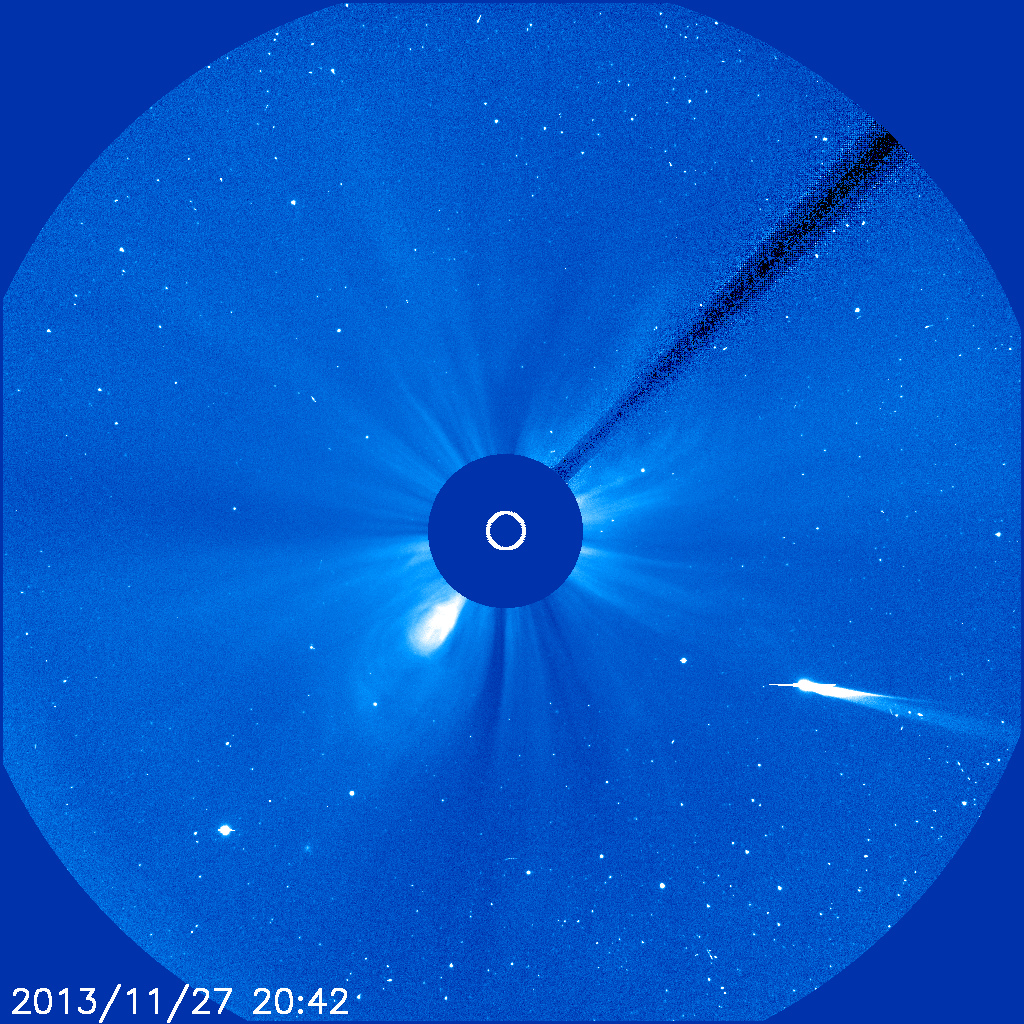
Image credit: NASA SOHO
ISON entered SOHO Lasco C3 early on November 27 and first images are already here. A solar flare and CME decided to join on the image below:
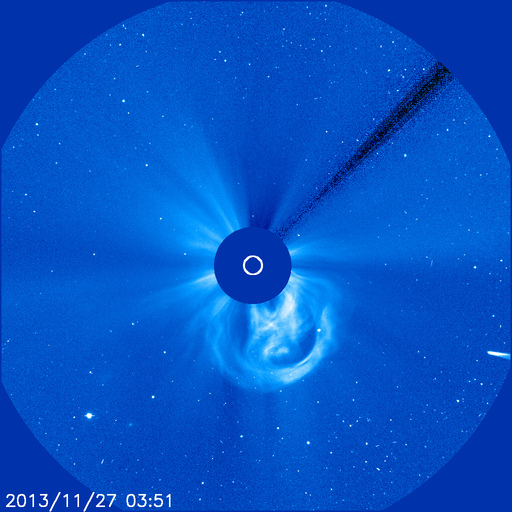
Image credit: NASA SOHO
The source of the cloud is a farside active region, which is not directly facing the comet.
You can watch ISON's passage and perihelion on space-based solar observatories now. Find all the links and timetable here.
November 26, 2013
T -2
Early this morning Comet ISON entered STEREO Behind COR2 field of view.
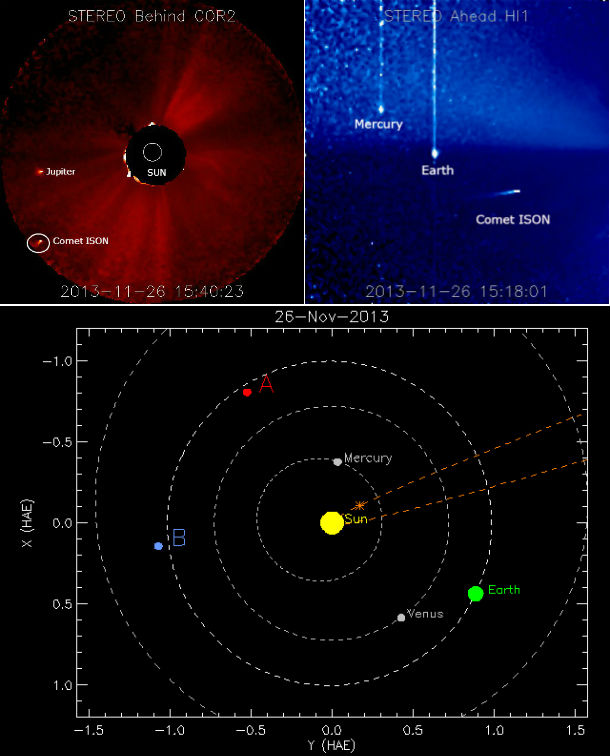
Comet ISON seen on STEREO B COR2 and STEREO A HI1 images. Lower image shows position of planets and spacecrafts on November 26, 2013 (Credit: STEREO/NASA)
According to astronomer Karl Battams of NASA's Comet ISON Observing Campaign, reported fading emission lines could indicate that the nucleus has completely disrupted, releasing an enormous volume of dust while significantly reducing emission rates.
Jakub Černý posted this today:
No good news from STEREO-A. Matthew Knight has sent me his photometry of spacecraft images to 15UT 25. Nov. They well corresponds to latest visual observations. After strong fade, comet has started to gaining brightness again. Unfortunately with speed far bellow (n=0.66) brightening for simple reflecting body (n=2). If we assume that all brightness coming from dust cloud, there is nothing inside coma that can resupply dust to coma at least on same level. What is worst, deviation from average activity level keep growing. Such characteristic more corresponds to slowly scattering dust cloud, then intact comet.
http://www.kommet.cz/datas/users/ison-lc-perv2_1.png
Best regards,
Jakub Cerny
The International Astronomical Union’s Minor Planet Center has just issued an updated predictions for Comet ISON. A maximum brightness of about first magnitude is forecast at perihelion with the comet entering the morning sky in early December no brighter than magnitude 3.5.
November 25, 2013
T-3 – Molecular emission drastically fallen
Latest update from CIOC: "We are seeing reports online that molecular emission from the comet has fallen dramatically, meanwhile dust production seems to be enormous. What this could indicate is that the nucleus has completely disrupted, releasing an enormous volume of dust while significantly reducing emission rates. Fragmentation or disruption of the nucleus has always been the highest risk factor for this comet so if this has indeed happened then while unfortunate, it would not be a surprise.
However, these reports are new, and while they are undoubtedly valid, we do still need to keep observing the comet to be sure what it happening. Remember: Comet ISON is a dynamically new sungrazing comet, fresh in from the Oort Cloud, and the last time we saw an object like this was never! Furthermore, a sungrazing comet just three days from perihelion has never been studied in this kind of detail – we're breaking new ground here! When we factor in your standard "comets are unpredictable" disclaimer, what we have is a huge recipe for the unknown."
Rapid fading of the molecular emission lines
Astronomers using the IRAM millimeter telescope in Spain and James Clerk Maxwell Telescope in Mauna Kea, Hawaii are reporting consistent, rapid fading of the molecular emission lines between November 21 and November 25 by at least a factor of 20. According to Michal Drahus of Caltech, this may indicate that the nucleus is now at best marginally active or that it no longer exists.
NASA released movie from the STEREO-A spacecraft's Heliospheric Imager showing the comet over a five-day period from November 20 to November 25, 2013.

Comet ISON is expected to pass through the Sun's atmosphere at just about 1.2 million km (730 000 miles) above the solar surface on November 28, 2013 at 18:44 UTC.
Space-based solar observatories phase
Comet ISON is now entering the fields of view of space-based solar observatories and will be viewed first in what’s called coronagraphs, images that block the brighter view of the Sun itself in order to focus on the solar atmosphere, the corona.
Both STEREO spacecraft will have a view of the comet in the COR1 and COR2 coronagraphs in the hours around closest approach on November 28.
The coronagraphs on STEREO Ahead will be able to see the comet for about a day and half between about 04:00 UTC on November 28, and 13:00 UTC on November 29. The Behind coronagraphs will have a longer look at the comet, from about 06:00 UTC on November 26 until the end of the day on November 29. During the period when Comet ISON is closest to the Sun, it will actually pass in front of the Sun as seen from Behind.
STEREO-A will be the only one that sees the comet transit across the face of the Sun.
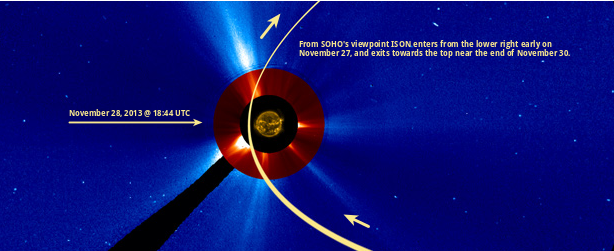

Image credit: NASA SDO. Edit: The Watchers
NASA’s Solar Dynamics Observatory, or SDO, will view the comet for a few hours around perihelion. SDO’s imagery should be detailed enough to gather information about how the comet evolves through the radiation and pressure of the Sun’s atmosphere.
SDO spacecraft will off-point at three different positions as Comet ISON moves through perihelion. This website will display near realtime images and movies. Images should begin appearing sometime between 17:44 and 18:00 UTC (12:45 pm and 1:00 pm ET). The Sun will appear in the upper right corner of the images and Comet ISON will move through the images from the lower right to the upper left.
SDO home page will have images from four of the AIA wavelengths during each the views (off points), Approach, Perihelion, and Departure. These wavelengths were chosen because in December 2011, when Comet Lovejoy passed perihelion, it was very bright in these wavelengths, and they believe they are the best choice for Comet ISON. We will not see a normal comet tail. The glowing material is forced to move along the Sun's magnetic field. It will look like a cloud moving along and away from the orbit of the comet.
From SOHO's viewpoint the comet enters from the lower right early on November 27 and exits towards the top near the end of November 30.
Solar wind buffeting ISON and Encke
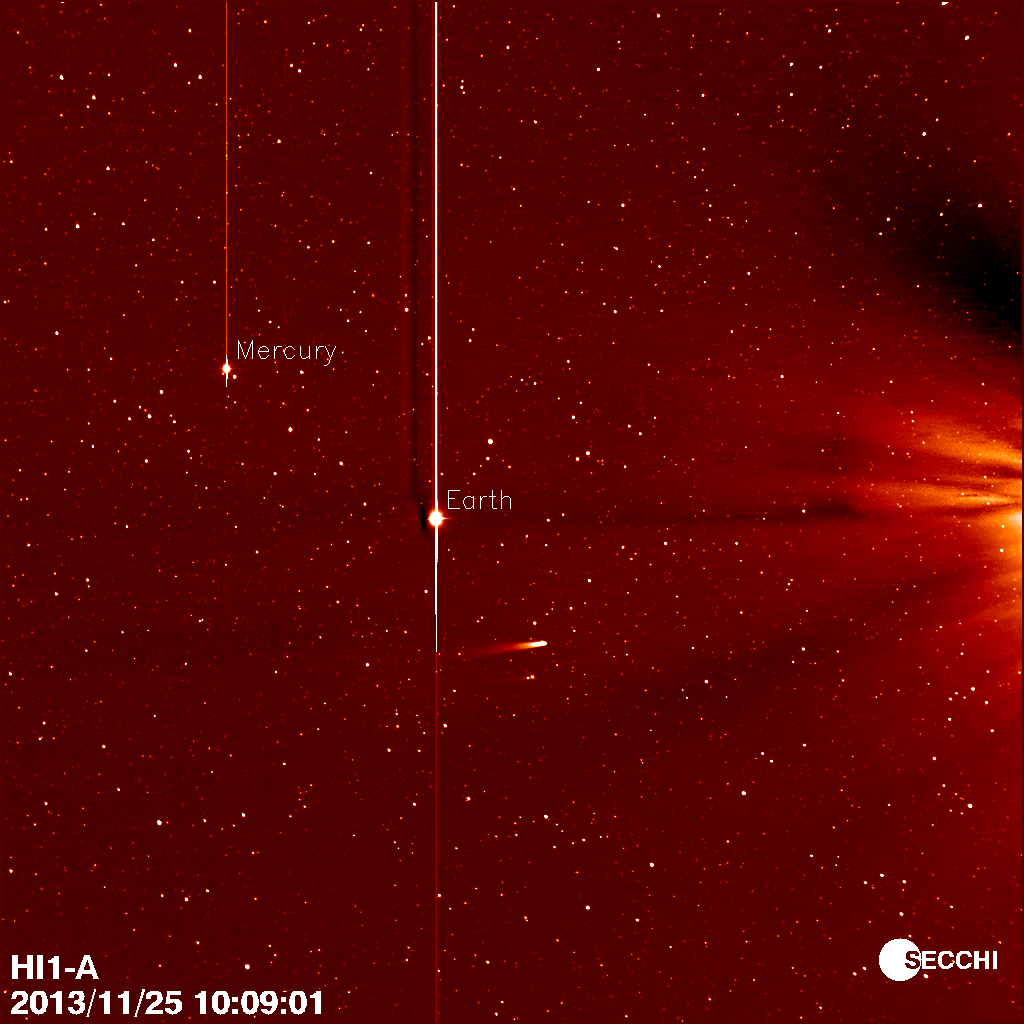

Image credit: NASA/STEREO
Click on the image for November 21 – 23 animation. Image credit: NASA/STEREO
November 24, 2013
T-4
ISON continues its journey towards the Sun, and it appears to still be in one piece. Ground based observations are now almost impossible, and we've entered the realm of solar spacecraft observing.
The next few days are where the fun really begins. (CIOC – Present)
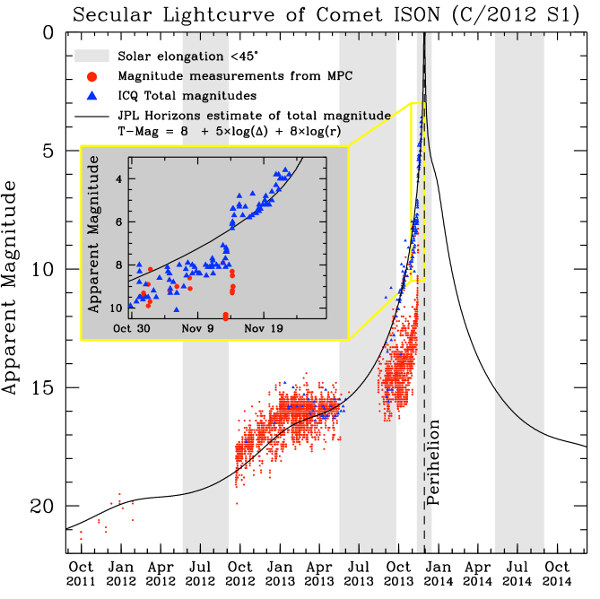

The latest light-curve for Comet ISON (compiled November 24, 2013 by Matthew Knight)
November 23, 2013
T-5
Five more days from ISON's perihelion. ISON is now clearly visible on STEREO Ahead HI1 images.
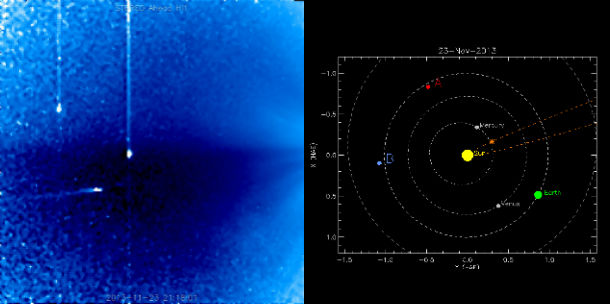

Comet ISON on November 23, 2013 (Credit: NASA/STEREO)
C/2012 S1 (ISON) is now 45 million km away from the Sun and 129 million km (80 million miles) away from Earth.
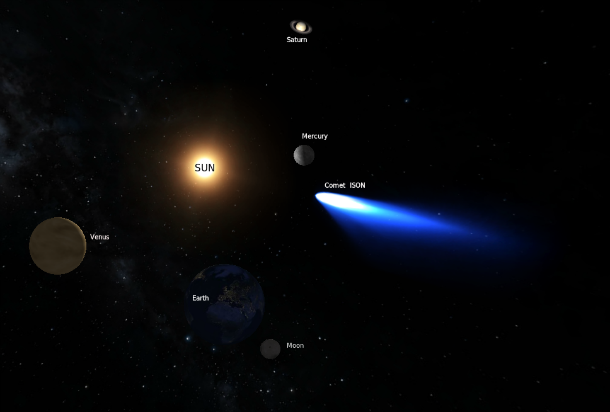

Location of Comet ISON on November 23, 2013 (Credit: Solar System Scope; Captions: The Watchers)
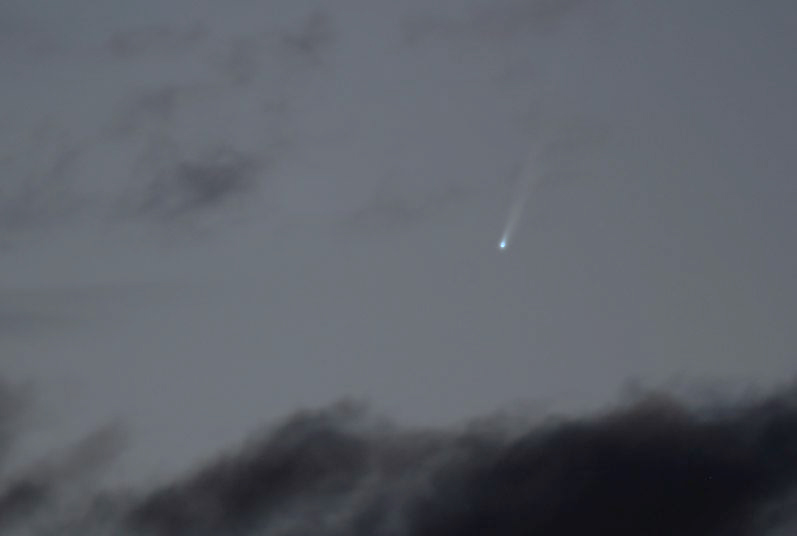

Taken by Vince on November 23, 2013 @ Los Angeles, CA via SpaceWeather
November 22, 2013
Comet ISON is now only six days from it's perihelion. According to an estimate by astronomists Jean-François Soulier and Alain Maury, ISON is still 4th magnitude. There are no changes in structure of the comet or it's tail. ISON is becoming much harder to detect as it gets lower at the horizon every day. Fritz Helmut Hemmerich took this great image from Tenerife, Canary Island:
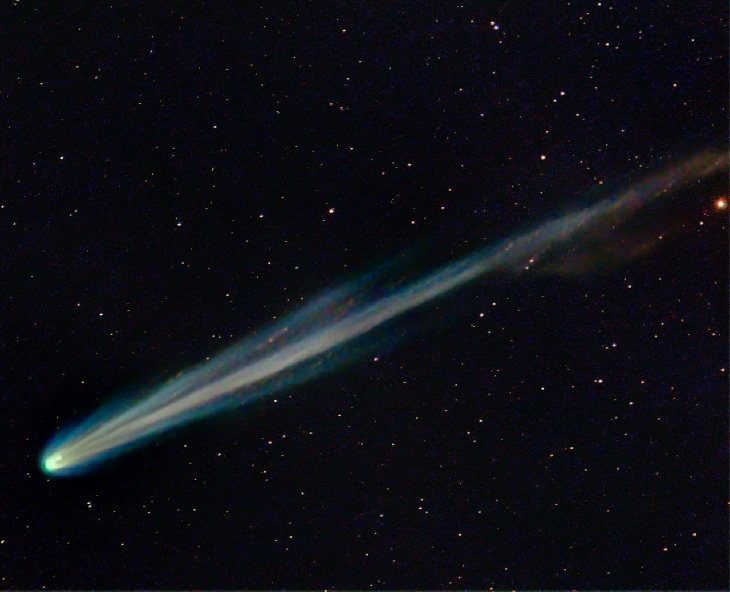

Comet ISON imaged from Canary Islands (Credit: Fritz Helmut Hemmerich via SpaceWeather)
Comet ISON above the French riviera (Nice)
.png)
.png)
Taken by MANU ANTUNA on November 22, 2013 @ COL DE VENCE – FRANCE – via SpaceWeather
November 21, 2013
Comet ISON enters STEREO Ahead HI1 field of view.
ISON can be seen in these images along with Earth, Mercury and Comet 2P/Encke. The tails streaking out from behind both comets can be seen moving along with the steady stream of particles – called the solar wind – that flows out from the Sun. Image credit: Karl Battams/NASA/STEREO/CIOC.


Comet ISON seen in the lower left corner of STEREO Ahead HI1 image. First entry was recorded at 21:34 UTC on November 20, 2013. (Credit: STEREO/NASA)
Because Comet ISON is seen only early in dawn, it will soon be impossible for cameras on Earth to track it. Juan Carlos Casado photographed the comet over the Teide Observatory in the Canary Islands at the dawn of November 21, 2013:
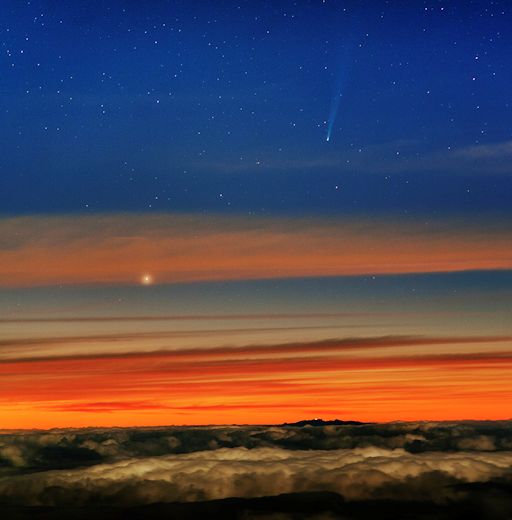

Comet ISON seen from Gran Canary at dawn of November 21, 2013. Lower left is Mercury. (Credit: Juan Carlos Casada via SpaceWeather)
This morning several astronomers recorded a tail disconnection event — a blob of the ion (gas) tail being pinched off by a gust of the magnetic-field-bearing solar wind, and blowing downstream.
November 20, 2013
Only 8 days to perihelion. Astronomers are getting more and more exciting as Comet ISON approaches the Sun. Early today ISON was positioned roughly between the bright star Spica and the planet Mercury. Now is the right time if you wish to see Comet ISON with naked eye because It’s appearing much lower each morning as it approaches the Sun.
.png)
.png)
Orbital elements and sky map for Comet ISON on November 20, 2013 (Credit: Solar System Scope/MPC)
Start looking an hour before your local sunrise and continue as dawn grows brighter. The planets Mercury and Saturn and the star Spica help to point the way.
Vitali Nevski, ISON's co-discoverer, estimated its brightness at magnitude 3.7 this morning in Russia. John Bortle in New York State calls it 4.5 but was nevertheless struck by its new brilliance.
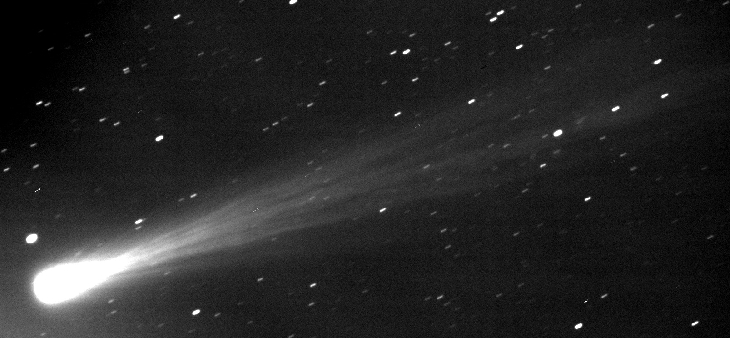

New image of Comet ISON taken early on November 20, 2013 by Vitali Nevski (Credit: Vitali Nevski via SpaceWeather.com)
“We might witness a nice, long-tailed comet visible to the naked eye that will leave millions of people with fond memories for a lifetime, or maybe it will be a small comet for sky hunters using binoculars and a good map of its position. Or it might yet break up and vanish.” Alan MacRobert, senior editor of Sky & Telescope magazine
In the meantime, the FORTIS payload was successfully launched this morning to observe Comet ISON. Launched on a Black Brant IX sounding rocket, the payload flew to an altitude of 172 miles before descending via parachute at White Sands. Preliminary reports show that good data was obtained and the mission was a success. Payload recovery is in progress.
November 19, 2013
Another outburst
The scientists using the European Southern Observatory's TRAPPIST telescope are this morning reporting that comet ISON is again in outburst!
Overnight they have seen a six-times increase in production rates (gases, water). This is not as large as the outburst last week that saw a ten-or-more-fold increase in production, but this is still a very significant outburst. They note that they are just about at the end of their observing run but will continue to follow up as much as they can.
There had been reports of "coma wings" in processed images of the comet, and these are a feature that has been associated with fragmentation of comet nuclei. We blogged about this yesterday with the main conclusion being that yes it certainly could mean fragmentation, but also could mean one of several other things that have nothing to do with fragmentation. Thus we urged continued imaging and community-wide discussion of this feature. Overnight we have heard that those "coma wing" features appear to have faded. Does this mean ISON has definitely not fragmented? No, but it lends weight to the belief that it's still in one piece. (Source: CIOC – Present)
Observing conditions are becoming extremely difficult, and very few pre-perihelion days remain for useful ground-based observations.
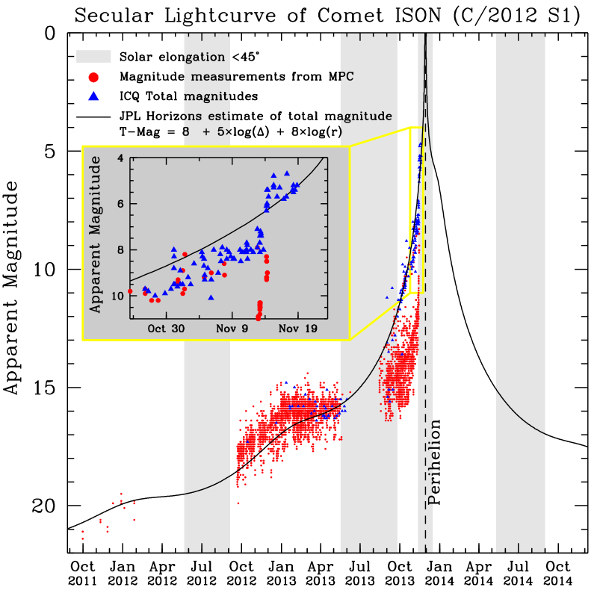

The latest light-curve for Comet ISON (compiled November 19, 2013 by Matthew Knight)
CIOC released new updated light curve image by Matthew Knight. The post-outburst observations are very evident but note that there are no new observations that include the second outburst. It will be a day or so before that information comes in. Furthermore, data points are going to be scarce now for all the reasons we just highlighted about how difficult ISON is becoming to observe.
In the meantime, FORTIS rocket launch to observe Comet ISON has been rescheduled for the morning of November 20 because of a payload issue. FORTIS will join a world-wide contingent of observatories trying to understand this early bit of our solar system's history.
November 18, 2013
10 days to perihelion
Comet ISON is now 74 million km away from the Sun and 129 million km away from the Earth. It's closest approach to the Sun is on November 28, 2013 at 18:44 UTC.
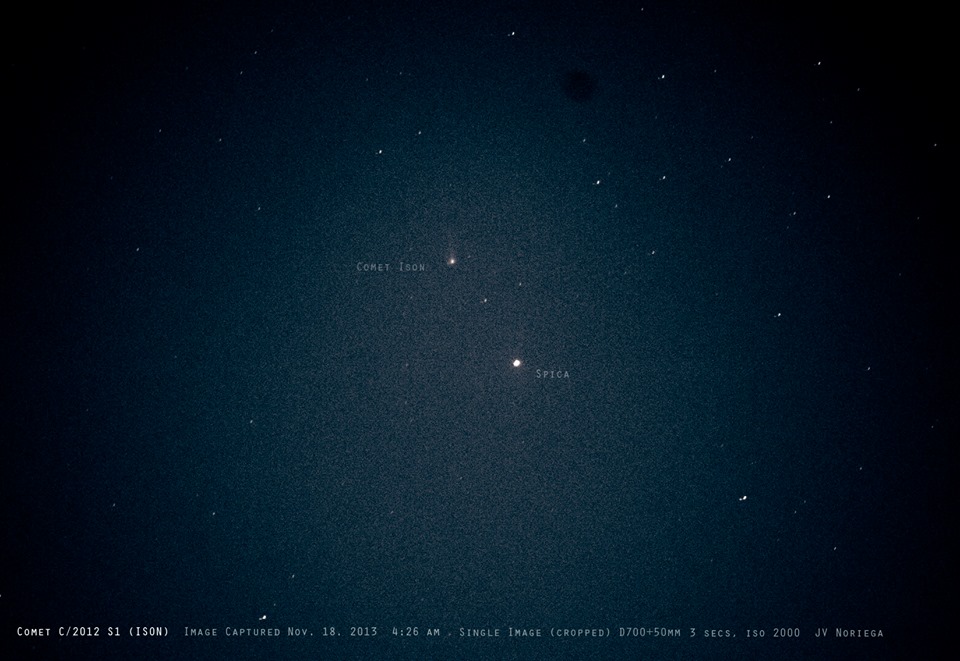

Comet ISOn seen near bright Spica on November 18, 2013 from Manila, Philippines (Credit: JV Noriega)
It is still unclear what exploded from the ISON's core on November 14th but it created a spectacularly-long tail which is now more than 16 million kilometers. Take a look at its image taken by Michael Jäger on November 17th at SpaceWeather.
The animation below consists of 8 images, each a 3-image median combine stack, all with a r' filter, from 11:43 to 12:53 UTC, November 14, made by Bruce Gary using a Celestron 11-inch telescope. Filamentary structure can be seen moving away from the sun at high speed. The motion of jets that can be seen first on the side is backwards and toward the center of the tail.
Animation credit: Bruce Gary
November 16, 2013
According to some observers ISON is 10 times brighter today than it was on November 13th, prior to its outburst, and its tail extends more than 8 million kilometers.
Because of so much gas and dust spewing from its core it is impossible to see what caused the outburst on November 14th but one possibility is that nucleus has completely fragmented.
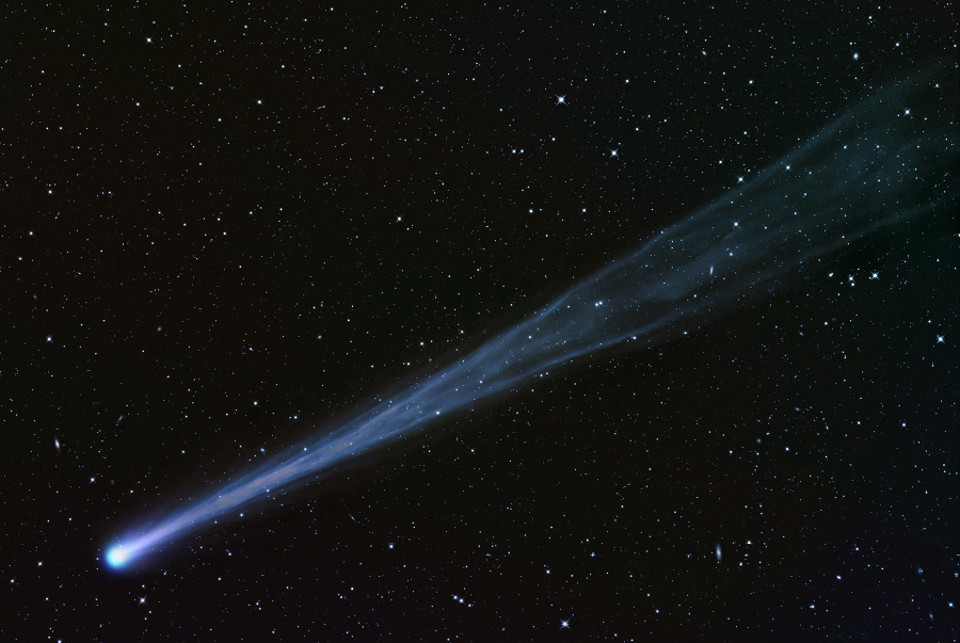

German amateur astronomer Waldemar Skorupa recorded this image from Kahler Asten, in Germany, on November 16, 2013. (Credit: Waldemar Skorupa via spaceweather.com)
"If so, it will still be several days before we know for sure," says Karl Battams, an astronomer with NASA's Comet ISON Observing Campaign. "When comet nuclei fall apart, it’s not like a shrapnel-laden explosion. Instead, the chunks slowly drift apart at slightly different speeds. Given that ISON’s nucleus is shrouded in such a tremendous volume of light-scattering dust and gas right now, it will be almost impossible to determine this for at least a few days and perhaps not until the comet reaches the field of view of NASA's STEREO HI-1A instrument on November 21, 2013. We will have to wait for the chunks to drift apart a sufficient distance, assuming they don't crumble first."
November 15, 2013
Outburst continues and today's images reveal multiple streams. Damian Peach captured this awesome image of ISON today:
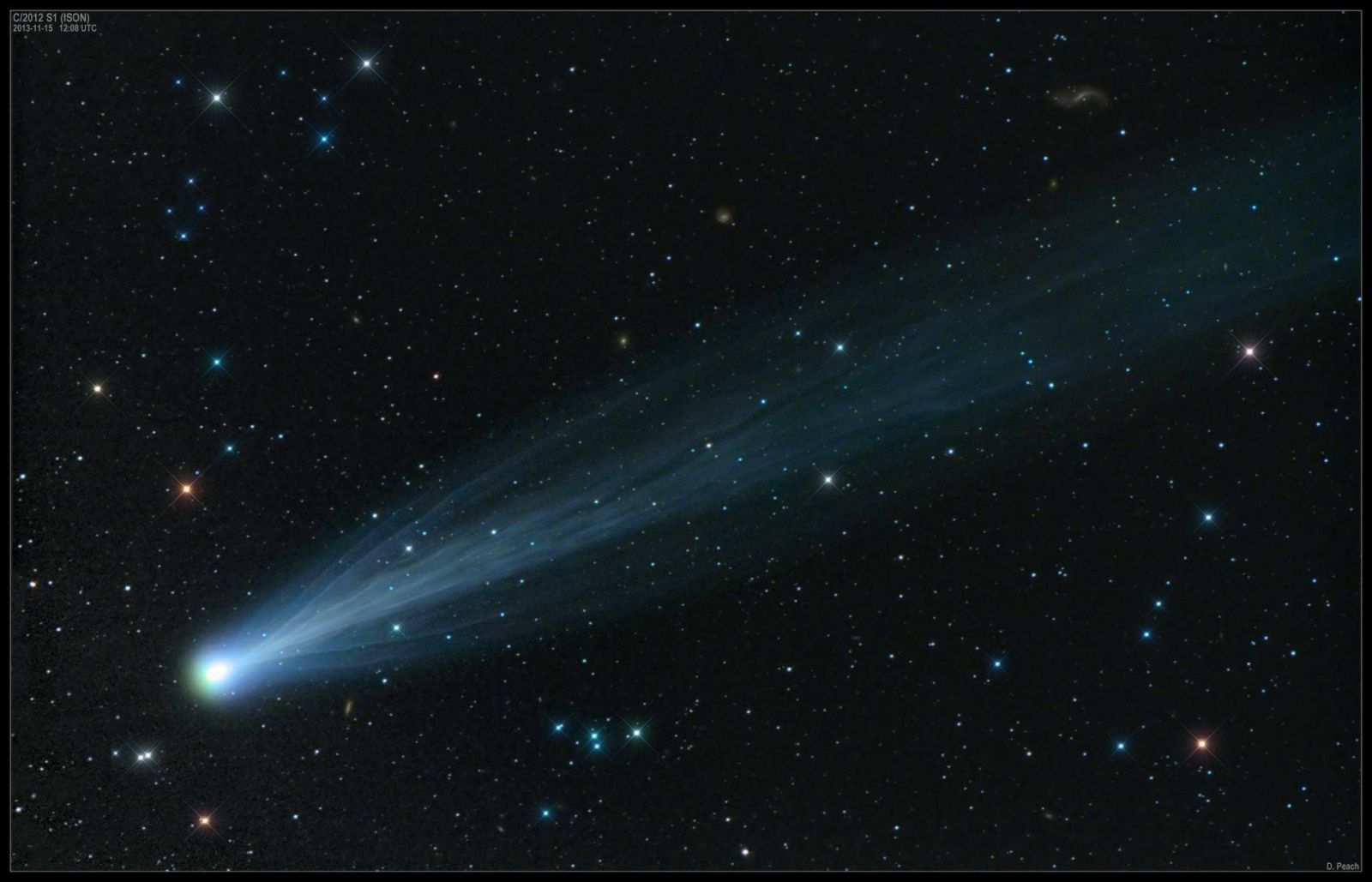

Image copyright: Damian Peach. November 15, 2013
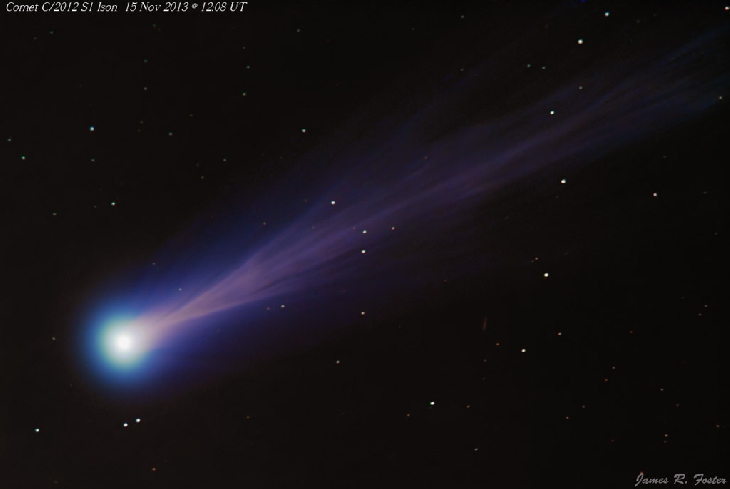

Comet ISON taken by James Foster on November 15, 2013 from Chuchupate, Lockwood Valley, California (Credit: James Foster via SpaceWeather.com)
The TRAPPIST national telescope at ESO's La Silla Observatory obtained new image on the morning of November 15, 2013. TRAPPIST has been monitoring comet ISON since mid-October, using broad-band filters like those used in this image. It has also been using special narrow-band filters which isolate the emission of various gases, allowing astronomers to count how many molecules of each type are released by the comet.
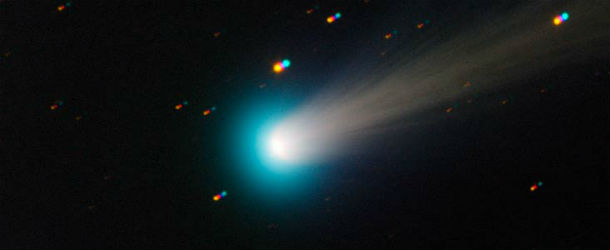

Comet ISON outburst seen on November 15, 2013 (Credit: TRAPPIST/ESO)
November 14, 2013
Outburst
Observers around the world are reporting that Comet ISON brightened sharply last night and is now at the threshold of naked-eye visibility. By some reports, ISON surged in brightness by approximately 2 magnitudes over last 24 hours and is now brighter than comet Lovejoy.
If this trend continues, it will be a faint but easy naked-eye object by the end of the week, SpaceWeather reports.
- Read more about it here.
Meanwhile, Solar System Scope team have added a second view at their 3D model of ISON's approach. Now you can switch to "View from Earth" and see the position of ISON in your night sky.
The link to the updated 3D model is here www.solarsystemscope.com/ison
- If you'd like to share your images of ISON with us send them via this form. Be sure to include description with date taken and your name. You can include a link to your website or gallery, Flickr/Facebook/Twitter/…/ profile, copyright notice or any text you'd like to go with the image. You can also contact us with the link to the image.
November 13, 2013
Fifteen days from perihelion, Comet ISON is brightening fast, is interacting with the solar wind, and appears to be undergoing an outburst. Reported magnitudes are of the order of +8 to +7, making ISON visible to most people in binoculars. The nucleus is still intact. However, noticeable brightening and increased rates of dust and gas production are being reported.
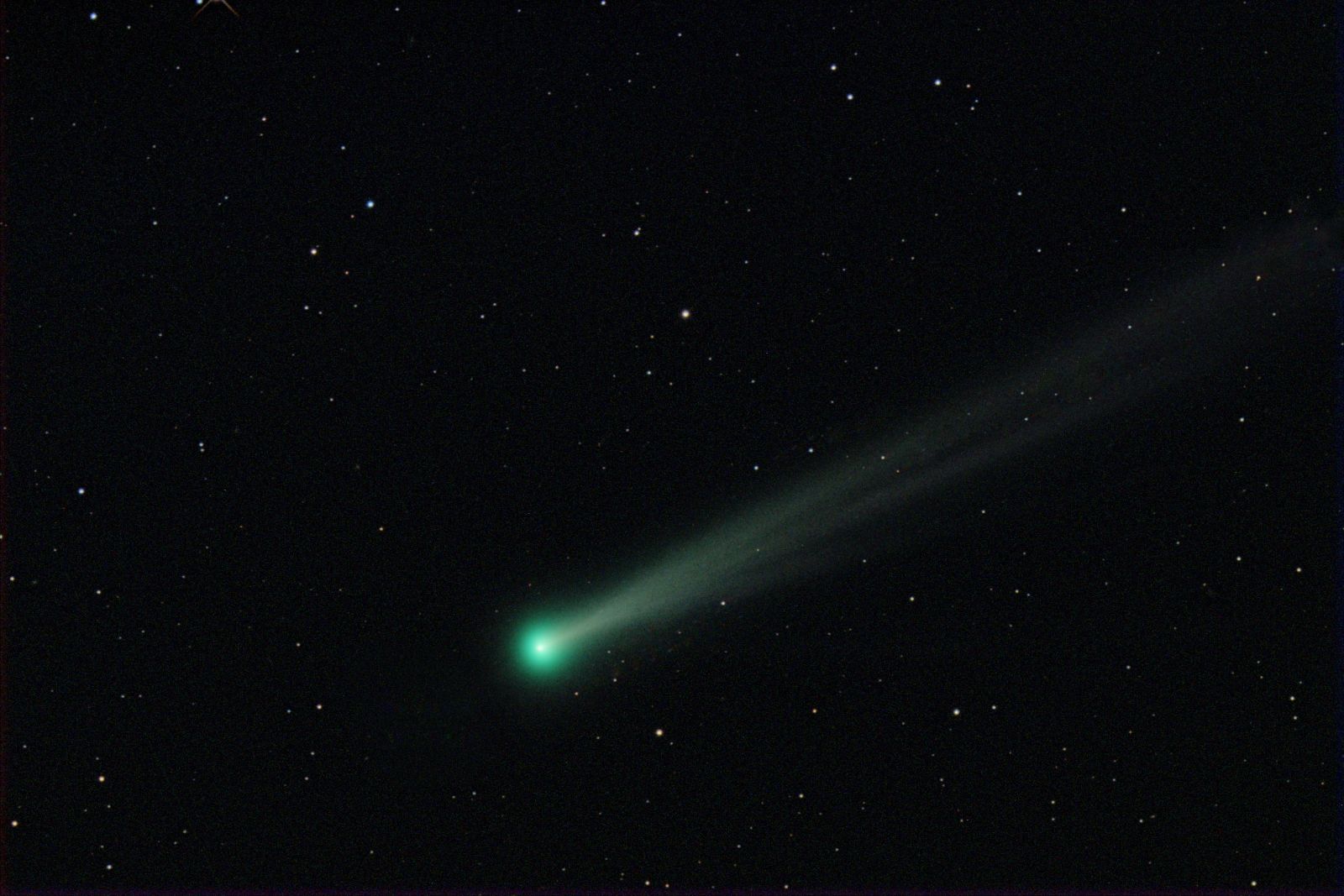

Comet ISON on November 13, 2013 taken by Gregg Ruppel from Ellisville, MO, USA (Credit: Gregg Ruppel via SpaceWeather.com)
November 11, 2013
Comet C/2012 S1 (ISON) is now inside the orbit of Venus, and has only seventeen days left before it reaches its closest point to the Sun, on November 28, 2013. But Comet ISON is moving extremely fast now at around 50 km/s (180 000 km/h, 112 000 mph), and will soon become increasingly difficult to observe as it approaches twilight skies.
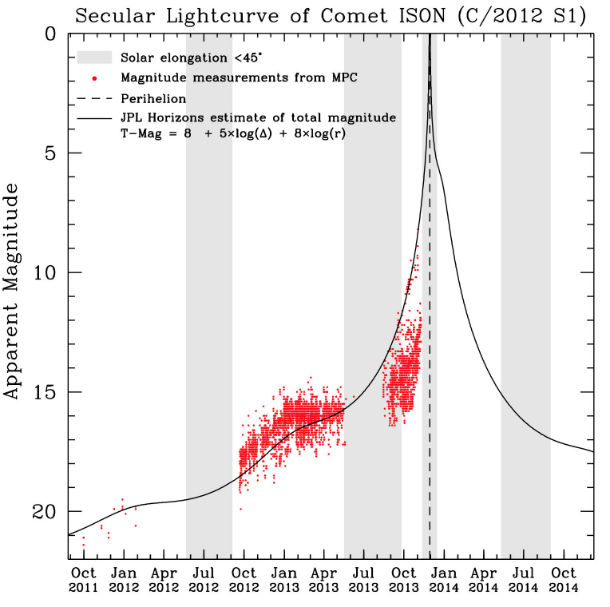

The latest light-curve for Comet ISON (compiled November 11, 2013 by Matthew Knight).
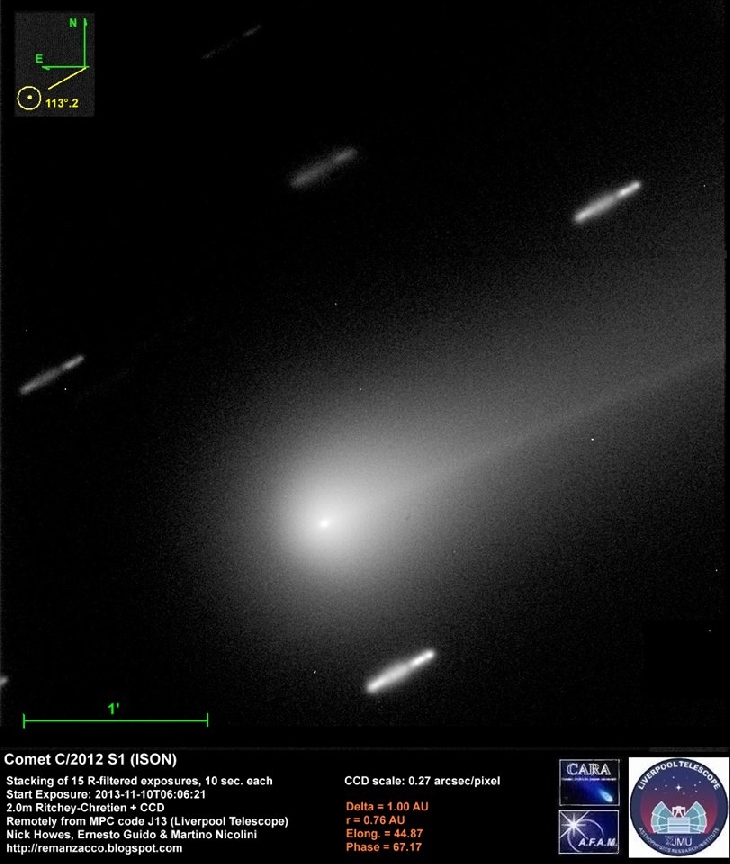

Comet ISON taken by Ernesto Guido, Nick Howes, Martino Nicolini on November 10, 2013 with the 2-meter Liverpool Telescope (Credit: Remanzacco Observatory/Guido/Howes/Nicolini)
November 10, 2013
Double tail feature is now visible. Michael Jäger took this image of ISON on November 10, 2013. One tail is the ion tail. It is a thin streamer of ionized gas pushed away from the comet by solar wind. The filamentary ion tail points almost directly away from the sun. The other tail is the dust tail.
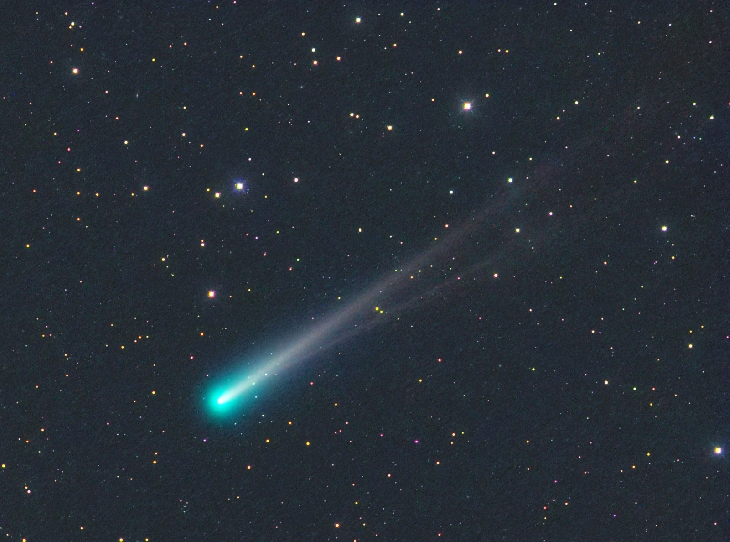

Taken by Michael Jäger on November 10, 2013 @ Jauerling Austria (Image credit Michael Jäger via SpaceWeather's Real-Time ISON gallery)
November 9, 2013
Multiple observers now report that Comet ISON could be seen by binoculars and backyard optics. Comet ISON is currently moving through the constellation Virgo low in the eastern sky before dawn. It is still too dim for naked eye.
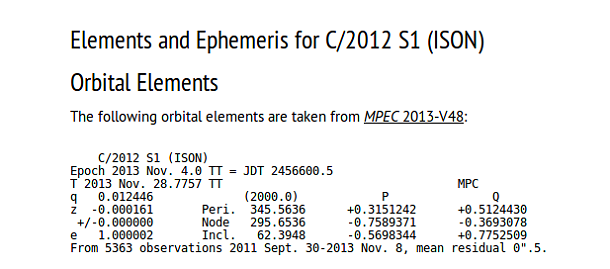

November 8, 2013
ISON is passing through the equinoctial point in Virgo around 20:00 UTC, passing into the southern celestial hemisphere and south of the ecliptic.
Comet ISON captured by astronomer Richard Dynes on November 8, 2013 using a C8 on a CGEM mount Canon 60Da camera and CLS filter from Arizona, US (Credit: Richard Dynes via SpaceWeather gallery)
November 7, 2013
Comet ISON is now inside the orbit of Earth and racing toward the Sun. Last night, astronomer Alberto Quijano Vodniza of Pasto, Colombia, recorded the comet moving through space at 165 762 km/h (103 000 mph / 46 km/s). Click here to see the animation.
Currently, Comet ISON is passing less than a degree from the +3.6 magnitude star Zavijava (Beta Virginis).
November 6, 2013
New image by Damian Peach shows some interesting activity within ISON's tail.
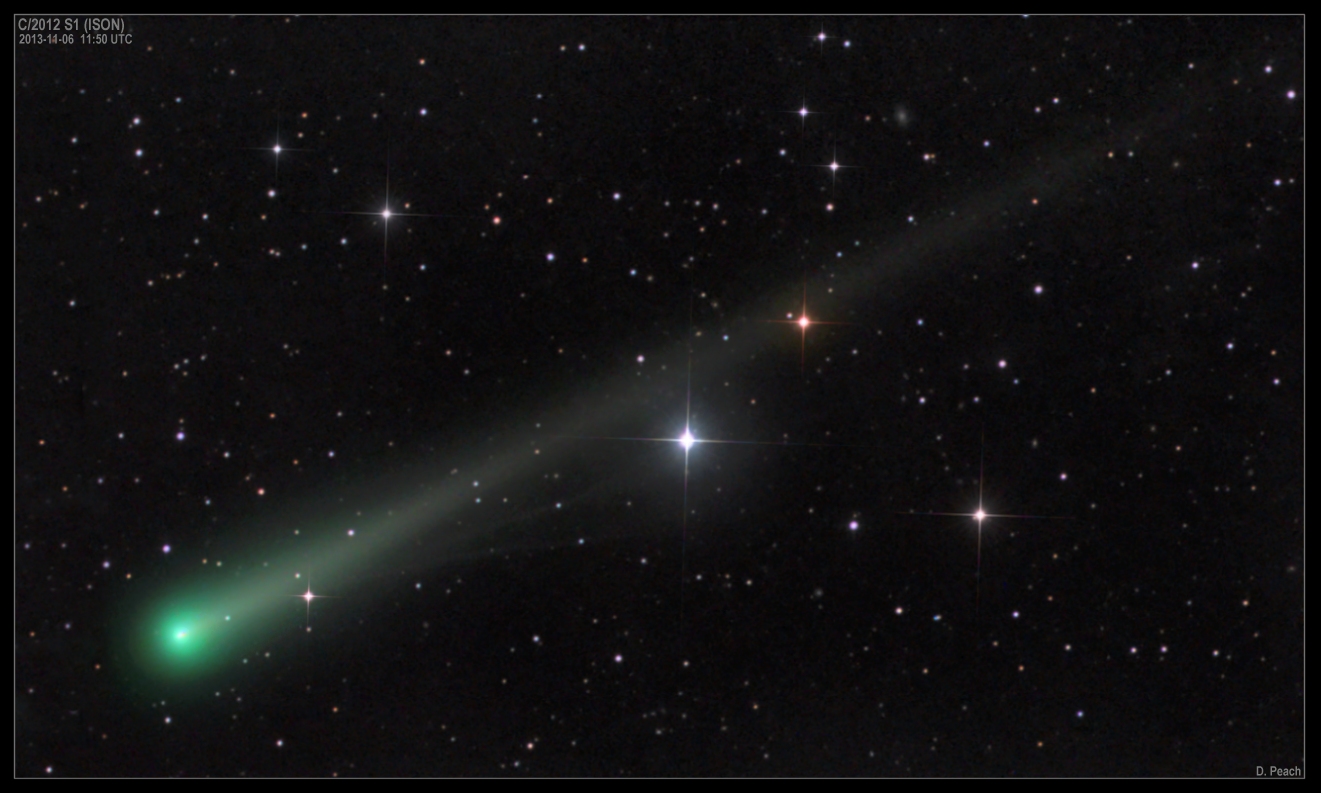

Comet ISON on November 6, 2013 (Credit: Damian Peach)
November 5, 2013
Casey Lisse of the Comet ISON Observing campaign (CIOC) reports that the Chandra X-ray Observatory just became the 9th spacecraft to image the comet. So far, eight spacecrafts have observed Comet ISON – SOHO, STEREO A, STEREO B, Spitzer, Deep Impact/Epoxi, Swift, Hubble and MRO. More observation attempts are expected from the ESA Venus Express and Proba-2 satellites, MESSENGER and the NASA Solar Dynamics Observatory.
Currently, Comet ISON is crossing the border from the astronomical constellation of Leo into Virgo.
October 30, 2013
Today, ISON is about 190 million km away from Earth traveling at speed of about 49.01 km/s relative to Earth. Its closest approach to Sun is in 28 days and 20 hours. This image was taken by Damian Peach on October 24th:
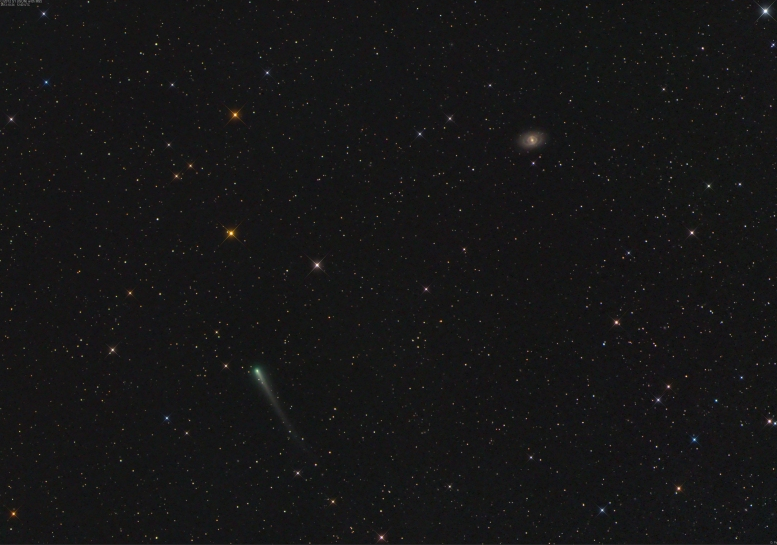

Comet ISON on October 24th, 2013. Image copyright: Damian Peach. 0.11m F5.6. STL-11k camera. LRGB: L: 6x3mins. RGB: 1x2mins. With Messier 95.
Check out his other images of our Solar System too. He has more ISON images here.
For better perspective on ISON's location and approach check this 3D model by Solar System Scope.
October 27, 2013
Justin Ng from Singapore used a telescope and special camera to create excellent time-lapse video of Comet ISON on October 27, 2013.
October 25, 2013
In the early morning of October 25, 2013 NASA's Marshall Space Flight Center in Alabama, US used a 14" telescope to capture image of Comet C/2012 S1 (ISON), which is brightening as it approaches the sun. The comet shines with a faint green color just to the left of center. The diagonal streak right of center was caused by the Italian SkyMed-2 satellite passing though the field of view.
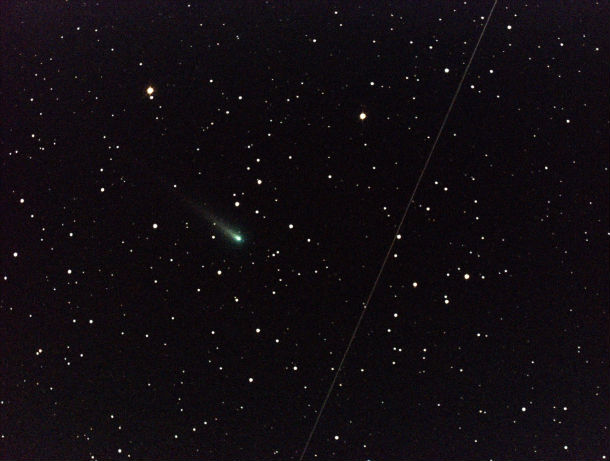

Comet ISON on October 25, 2013 (Credit: NASA/MSFC/Aaron Kingery)
Comet ISON is still too faint for the unaided eye or small binoculars, but at magnitude 8.5 it's now an easy target in a small telescope.
October 17, 2013
Officials with the Space Telescope Science Institute in Baltimore, which operates Hubble, wrote in a statement that in NASA Hubble Space Telescope image taken on October 9, 2013 the comet's solid nucleus is unresolved because it is so small. If the nucleus broke apart then Hubble would have likely seen evidence for multiple fragments according to statement.
The coma or head surrounding the comet's nucleus is symmetric and smooth, which would probably not be the case if clusters of smaller fragments were flying along. What's more, a polar jet of dust first seen in Hubble images taken in April is no longer visible and may have turned off.
A recent study reported that with a nucleus estimated to be between 0.12 miles and 1.2 miles across (0.2 to 2 km), the comet appears to be big enough to avoid destruction by the sun's heat.
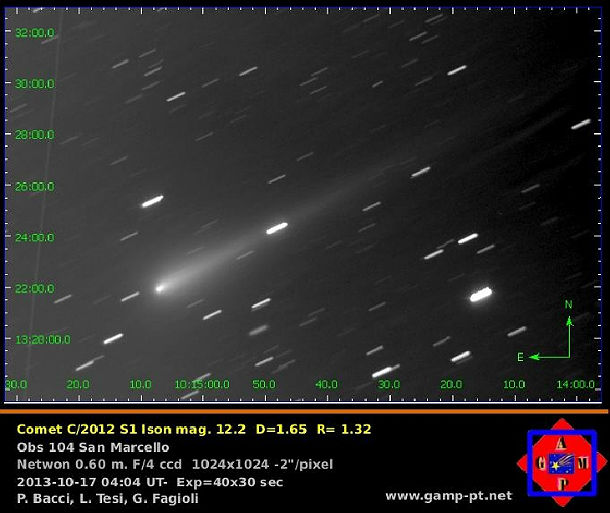

Comet Ison taken on October 17, 2013 from San Marcello, Italy (Credit: Bacci/Tesi/Fagiolo/GAMP-via SpaceWeather ISON gallery)
Currently, Comet ISON is 153 million miles (247 million km) away from Earth.
October 10, 2013
Researchers Kevin Walsh and Mathew Knight place the size of ISON’s nucleus in the range of 0.5 to 2 kilometres. Comet nuclei smaller than 200 metres in diameter, with an average density or lower typically do not survive a close passage to the Sun. So it looks this is encouraging news for ISON when it comes to surviving perihelion.
October 9, 2013
Comet ISON is inside Mars’ orbit and about 177 million miles from Earth. NASA's Hubble Space Telescope took photo of ISON and it appears the nucleus of ISON is intact.
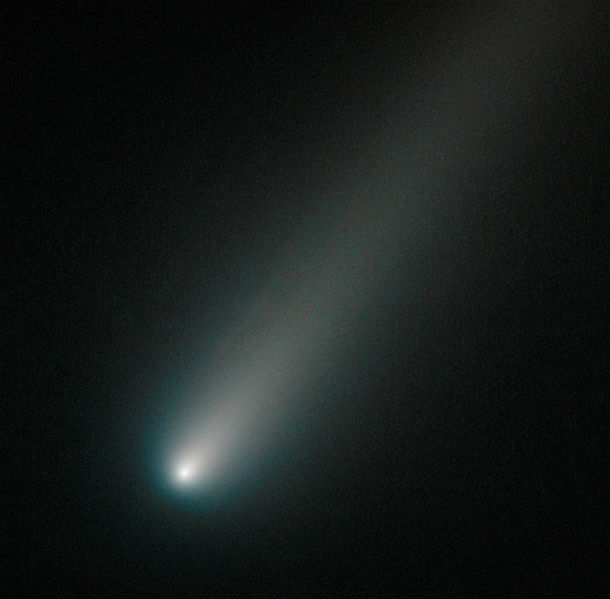

NASA's Hubble Space Telescope took this photo of Comet ISON inside Mars' orbit on October 9, 2013 (Credit: NASA, ESA, and the Hubble Heritage Team (STScI/AURA))
Meanwhile, new studies released at the American Astronomical Society’s 45th Annual Division for Planetary Sciences meeting in Denver suggests that ISON just could make it through its close perihelion passage near the Sun. Comet ISON is expected to be the most active and put on its best showing post-perihelion – if it survives.
The rotational pole of the nucleus indicates that only one side of the comet is being heating by the Sun on its way in until approximately one week before it reaches its closest point to the Sun. Research scientist Jian-Yang Li of the Planetary Science Institute noted that the reddish color of the coma of ISON suggests an already active comet sublimating water ice grains as they move away from the nucleus. Read more
October 6, 2013
Astronomer Efrain Morales Rivera captured approaching Comet ISON from Jaicoa Observatory in Aguadilla, Puerto Rico.
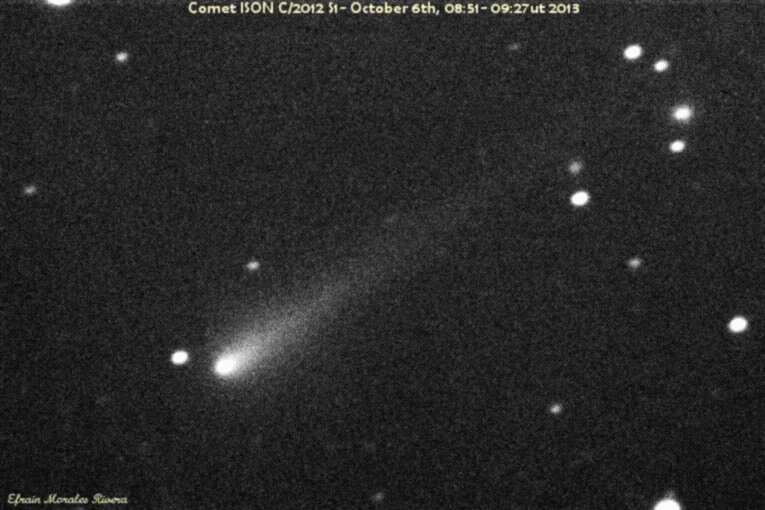

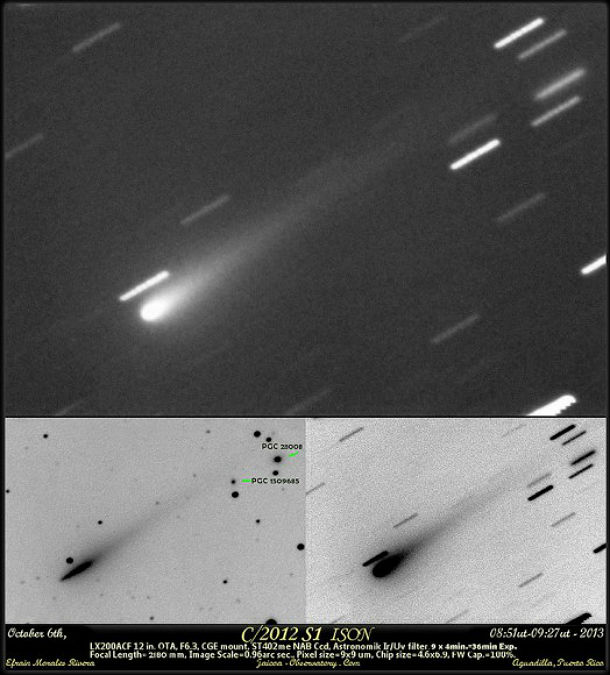

Comet ISON as imaged from Aguadilla, Puerto Rico recently on October 6th. (Credit: Efrain Morales Rivera)
October 5, 2013
Great images of ISON are now being taken by astronomers around the world. Michael Jäger from Austria, observed ISON on October 5 and combined multiple exposures through red, green, blue, ultraviolet and infrared filters to found out that it was green:
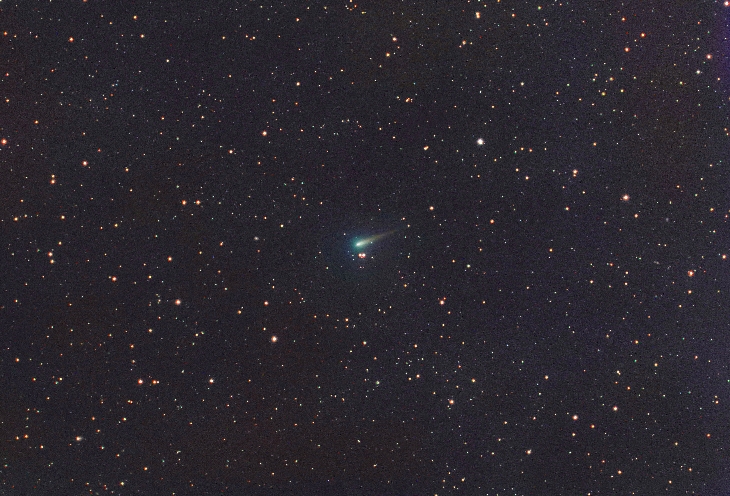

Photo by Michael Jäger / http://cometpieces-at.webnode.at/
ISON's green color comes from the gases surrounding its icy nucleus. Check more images at SpaceWeather's real-time ISON image gallery.
October 3, 2013
It seems Bruce Gary, Ignacio Ferrin and those who said ISON will not be what everybody hoped it would be were right. As it passed Mars ISON is still faint and Ferrin believes it is about to disintegrate. The light curve of ISON, he argues, resembles the light curves of other comets that have have fallen apart. However, many experts still believe the comet is on track to become a bright sungrazer in late November.
October 2, 2013
New images were released today from the High Resolution Imaging Science Experiment (HiRISE) camera on board the Mars Reconnaissance Orbiter (MRO). On September 29, 2013 MRO maneuvered to point its HiRISE camera at ISON. This is what it recorded on September 30th:
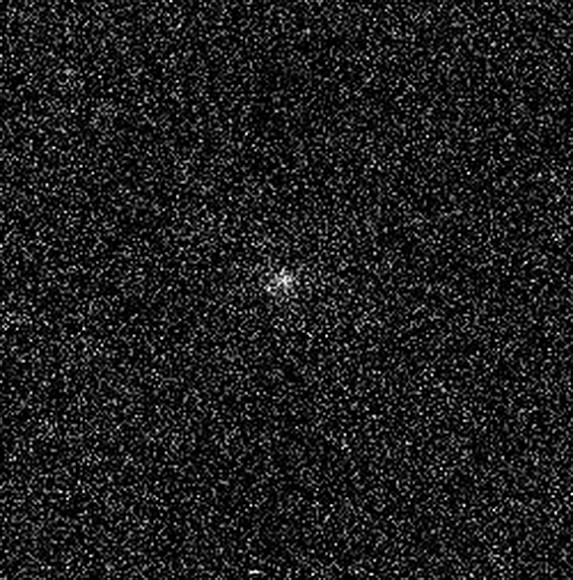

Image of Comet ISON acquired on September 30, 2013 with the HiRISE camera on NASA’s Mars Reconnaissance Orbiter. This is a preliminary single (non-stacked) image, and appears fuzzy in part because it still contains noise and background stars.
HiRISE saw a small spot at the position of ISON that is relatively bright, like a star, but moving relative to actual stars. The comet's coma is apparently very faint, so these data provide useful constraints on the size of the comet nucleus and its overall brightness, key measurements to understand its behavior and useful knowledge to subsequent observers. 

These images show a 256 x 256 pixel patch of sky at the range to the comet of 8 million miles and when the solar phase angle is 47 degrees. Three more observations of ISON were planned for 1 and 2 October as the comet moves through closest approach to Mars at 7 million miles, but with less illumination as seen from Mars.
Based on preliminary analysis of the data, the comet appears to be at the low end of the range of brightness predictions for the observation. As a result, the image isn't visually pleasing but low coma activity is best for constraining the size of the nucleus. This image has a scale of approximately 8 miles (13.3 km) per pixel, larger than the comet, but the size of the nucleus can be estimated based on the typical brightness of other comet nuclei. The comet, like Mars, is currently 241 million kilometers from the Sun. As the comet gets closer to the sun, its brightness will increase to Earth-based observers and the comet may also become intrinsically brighter as the stronger sunlight volatilizes the comet's ices. HiRISE
October 1, 2013
ISON flew by Mars today and images from the HiRISE camera of NASA’s Mars Reconnaissance Orbiter should be available within the next couple of days. That is, if they manage to resolve government funding because as of today, due to government shutdown, only essential NASA personnel is allowed to work. NASA's homepage is unavailable and none of its websites is being updated. Out of their 18 000 employees, only 600 will be allowed to work. Those 600 are the support to the International Space Station, other missions currently in operation off the surface of planet Earth, and critical operations at each site. That, apparently, includes Mars missions who were supposed to take pictures today.
Hopefully, ESA's Mars Express will have something for us very soon.
3D model of ISON's approach by Solar System Scope gives us a good idea where ISON is today. Scroll down the article for animated 3D model.
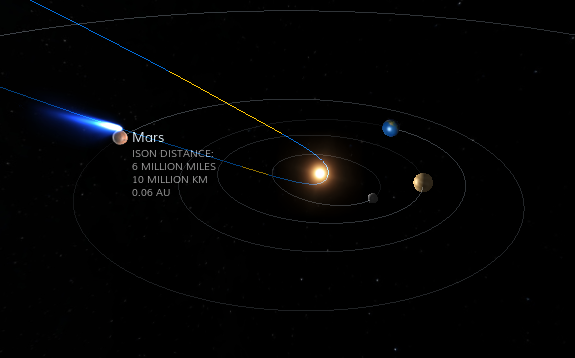

ISON's location on October 1, 2013. Image credit: Solar System Scope
September 29, 2013
ISON is approaching Mars for a 0.07 AU (10.5 million km) close encounter on October 1st. Mars satellites and rovers will have a close-up view.
Using a remotely controlled 14-inch telescope in New Mexico, Rolando Ligustri photographed ISON approaching Mars on September 28th:
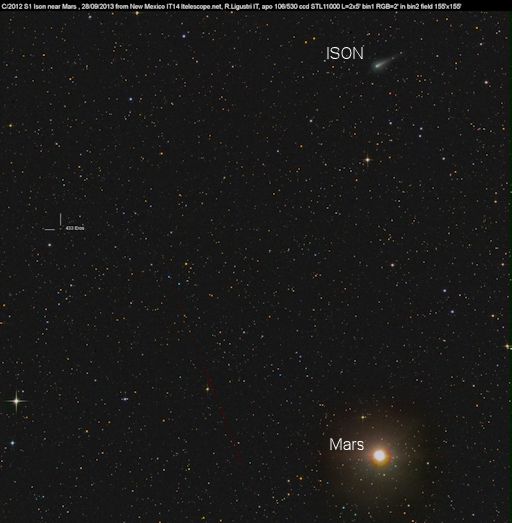

Image credit: Rolando Ligustri
The following NASA video details Mars fly by:


September 28, 2013
A sub-orbital balloon was launched to study ISON from above nearly all of the Earth's atmosphere. The Balloon Rapid Response for ISON or BRRISON, is built and managed for NASA by The Johns Hopkins University Applied Physics Laboratory. The baloon will also observe other science targets.
BRISSON is carrying a 0.8 m telescope and optical and infrared sensors to study the comet. It will observe Comet ISON in the near-infrared and in the near-ultraviolet and visible wavelength ranges at an altitude of 36 km (120 000 feet).
The near infrared camera will measure the ratio of carbon dioxide (CO2) to water (H2O) emissions from the cometary nuclei as a vital diagnostic of the comet’s origins. These are unique observations that cannot be obtained by any other means. The near ultraviolet and visible camera will observe at the wavelength of the hydroxyl (OH) emission from Comet ISON and will test and characterize the effects of atmospheric turbulence on optical observations at balloon altitudes.
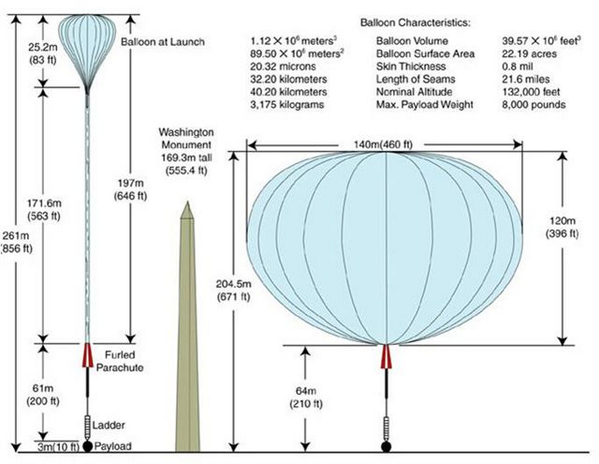

Update, October 29, 2013:
BRRISON suffers science payload anomaly, unable to collect data
FORT SUMNER, N.M.—The Balloon Rapid Response for ISON (BRRISON) payload suffered an anomaly following launch Sept. 28 from the Columbia Scientific Balloon Facility in Fort Sumner, N.M., preventing the payload from collecting mission data.
Approximately two and a half hours after BRRISON’s launch, the 0.8-meter telescope on the gondola returned to a stowed position too rapidly, driving the telescope past a stow latch. The telescope was unable to be redeployed despite numerous attempts by the BRRISON team from the Johns Hopkins University Applied Physics Laboratory, which built BRRISON for NASA.
An Interim Response Team will assess the BRRISON payload during recovery operations later today.
BRRISON was launched to study the rare sun-grazing Oort Cloud Comet ISON and other objects with both infrared and ultraviolet/visible light instruments. (Source)
September 25, 2013
Today, Comet ISON is 345 million kilometers away from Earth traveling at speed of 31.90 km/s. Throughout September ISON's average speed was 109 366 km/h or 67 957 mph.
It is about as bright as a 14th magnitude star, which is not as bright as some astronomers expected. Nevertheless, according to several experts Comet ISON is still on track to become an impressive sungrazer. John Bortle predicts ISON will rival Venus during the hours leading up to its closest approach to the Sun in November, while Matthew Knight notes that Comet ISON is brighter than Comet Lovejoy was at the same distance from the sun in 2011.
On the other hand, Bruce Gary noticed fading which he described as "unphysical". Though he says he is an amateur on comet matters he has a very impressive analysis on his website.
This is what he has to say about it:
Measurements on several dates (after reappearing from behind the sun) show that the comet is brightening at a lower rate than expected, as if the activity level on the nucleus surface is actually decreasing! ISON has probably passed the "frost line" so why isn't it brightening instead of fading with respect to a model? I've begun to lose interest in this comet, which may never become visible to the unaided eye. I wonder why someone ever suggested that it could become "comet of the century"?
Check out SpaceWeather's image gallery for latest images of Comet ISON.
September 24, 2013
Slooh.com’s Canary Islands Observatory captured asteroid 433 Eros seeming to fly with Comet ISON on September 24th, 2013. This 2nd largest near-Earth asteroid — which has been visited by the NEAR probe — is traveling faster, along a different orbit.


September 23, 2013
Comet ISON is still more than two months away from its spectacular close encounter with the Sun. Already, the comet has become a good target for backyard telescopes in the pre-dawn sky.


September 17, 2013
ISON is 383 million kilometers away from Earth traveling at a speed of 30.66 km/s (110 376 km/h) as it approaches Mars. It has long passed Jupiter and will flyby Red Planet on October 1, 2013, at about 17:24 UTC. It will continue to accelerate steadily until November 28 when it is expected to whip around the Sun at an astonishing speed of 1 359 896 km/h (845 000 mph).
Early indications from students who have been processing data from NASA’s Swift satellite, estimate the comet to be around 4.82 km (3 miles) in diameter. They have reached this conclusion by observing the amount of ice and dust emitted from ISON’s surface as it falls through space toward the Sun.
Armada of ground based amateur astronomers and an unprecedented space fleet is tracking and waiting for ISON as it moves through our Solar System to meet the Sun on November 28, 2013. It is however, still to early to make final forecast as to what will happen to it. If ISON survives the Sun, it will deserve to be called "the comet of the century" because in that case it might emerge so bright it will become visible on Earth even in daylight. It is still a big IF, so November 28 is the day when we will know exactly. Check ISON scenarios below and definitely take a look at Alan MacRobert's video: "Comet ISON: The Straight Dope".
Comet ISON flying toward the Sun, 383 million kilometers away from Earth. Dennis Whitmer obtained 40 useful images of ISON on the morning of September 15, 2013. Then Bruce Gary used some of those images to create this GIF animation. Image credit: Dennis Whitmer/Bruce Gary
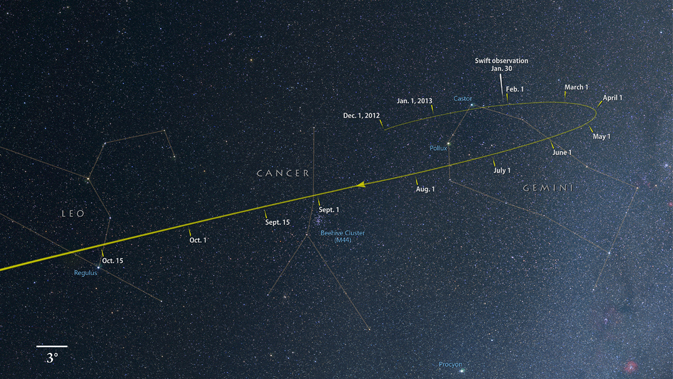

Comet ISON’s path through the constellations of Gemini, Cancer and Leo up until the end of October when ISON will be well on its way to perihelion due to occur on November 28, 2013. Image credit: NASA’s Goddard Space Flight Center
About Comet ISON
Comet C/2012 S1 was discovered in September 2012 by Russian astronomers Vitali Nevski and Artyom Novichonok using data from the International Scientific Optical Network (ISON). For that reason, it is also known as Comet ISON. This comet is on a close encounter with the Sun on November 28, 2013 – 18:44 UTC.
ISON scenarios
There are three possible scenarios for Comet ISON, scientists say. First one is fizzle, where ISON evaporates under intense tidal forces and solar radiation. Nobody hopes for this, but hey, it's a cruel world out there. The second scenario is break-up. In this scenario, ISON breaks into smaller chunks. This, by the way, might happen any time. The third scenario is what everybody hopes will happen – sizzle – ISON survives the Sun and emerges so bright it becomes visible on Earth in daylight.
Crossing the frost line
At the time of ISON's closest approach to Mars, on October 1, it will be 0.07 AU (10.5 million km) away from it and this flyby comes at a key time in ISON's journey as it will just cross the "frost line", the place outside the orbit of Mars where solar heating is enough to start vaporizing frozen water.
When it crosses the frost line, "the whole comet could erupt in geysers of gas," said Carey Lisse of the Johns Hopkins University Applied Physics Lab.
The amount of outgassing at Mars will give researchers clues to the size of ISON’s nucleus, which is hidden from view deep within the comet’s dusty atmosphere.
If ISON's nucleus is much bigger than 0.5 km, it will probably survive its brush with the Sun and turn into one of the most spectacular comets in many years.
How bright will it be?
In all honesty, none of our astronomers can be sure and say exactly how bright will ISON get simply because all comets, especially ones entering the inner solar system for the first time, like ISON, behave unpredictably and it is therefore impossible to reliably predict what ISON will do.
Comet ISON's approach – 3D model
The team at the Solar System Scope published this amazing 3D model of ISON's approach. This will give you a unique perspective of how ISON's approach looks like. Use your mouse to change viewpoint, zoom, change date, etc.
Comet ISON: The Straight Dope
The most recent observations indicate Comet ISON is on track to hopefully (but not definitely) reach naked-eye visibility in December 2013′s pre-dawn sky. S&T Senior Editor Alan MacRobert explains just why it’s so tricky to predict how bright ISON will be, and previews what you’ll need to know to spot it as it approaches the Sun for its close encounter.


Space fleet tracking ISON
Along with ground observations, an unprecedented space fleet is tracking ISON. When ISON passes Mars on October 1, space missions Curiosity, Opportunity, Mars Reconnaissance Orbiter and Mars Express will all capture and send data back to Earth. This will be the first milestone in observing the comet because ISON will just pass the "frost line" and we'll know more about its size and what to expect as it continues toward the Sun. On November 28, STEREO will play its special part because it's uniquely situated to observe the approach and perihelion passage of comet ISON in November 2013. The STEREO instrument teams — in particular the SECCHI team — are busy putting together observing plans to address a wide range of cometary and heliophysics science objectives. Other missions worth mentioning before the list are BRISSON – sub-orbital balloon due to launch on September 30, and Chandra X-ray Observatory which observes ISON's interactions with the solar wind. All of the missions have/had their important role and below is the list along with the links to their websites.
- Solar Dynamics Observatory: Observing ISON under extreme-ultraviolet light when the comet is closest to the Sun.
- SOHO: Observing ISON as it passes by the Sun.
- STEREO: Observing ISON as it passes by the Sun.
- MESSENGER: Observed ISON as it passed by Mercury on November 19th.
- Venus Express: Observing ISON as it passes by Venus.
BRRISON: Sub-orbital balloon launched mid September to study ISON from above nearly all of the Earth's atmosphere. Update: September 29, 2013 – The Balloon Rapid Response for ISON (BRRISON) payload suffered an anomaly following launch Sept. 28 from the Columbia Scientific Balloon Facility in Fort Sumner, N.M., preventing the payload from collecting mission data.- FORTIS: Sounding rocket will be launched in mid-to-late November to obtain ultra-violet spectra from ISON.
- Hubble Space Telescope: Observed ISON in April-May and will see it again in October and December (if ISON survives).
- Spitzer Space Telescope: Observed ISON on June 13. The comet was 500 million km or 310 million miles away from the Sun.
- Chandra X-ray Observatory: Observing ISON's interactions with the solar wind.
- International Space Station: Astronauts will be able to observe Comet ISON as it passes by the Sun in late November.
- Lunar Reconnaissance Orbiter: Observing ISON.
- Swift: In January and March, Swift observed ISON when it was 740 million km or 460 million miles away from the Sun.
- Curiosity: Observed ISON as it passed Mars on October 1.
- Opportunity: Also observed ISON as it passed by Mars.
- Mars Reconnaissance Orbiter: Orbital observations of ISON as it passed by Mars in October.
- Mars Express: Orbital observations of ISON as it passed by Mars in October.
- Deep Impact: Imaged ISON for the first time on 17 and 18 January 2013 from 493 million miles away.
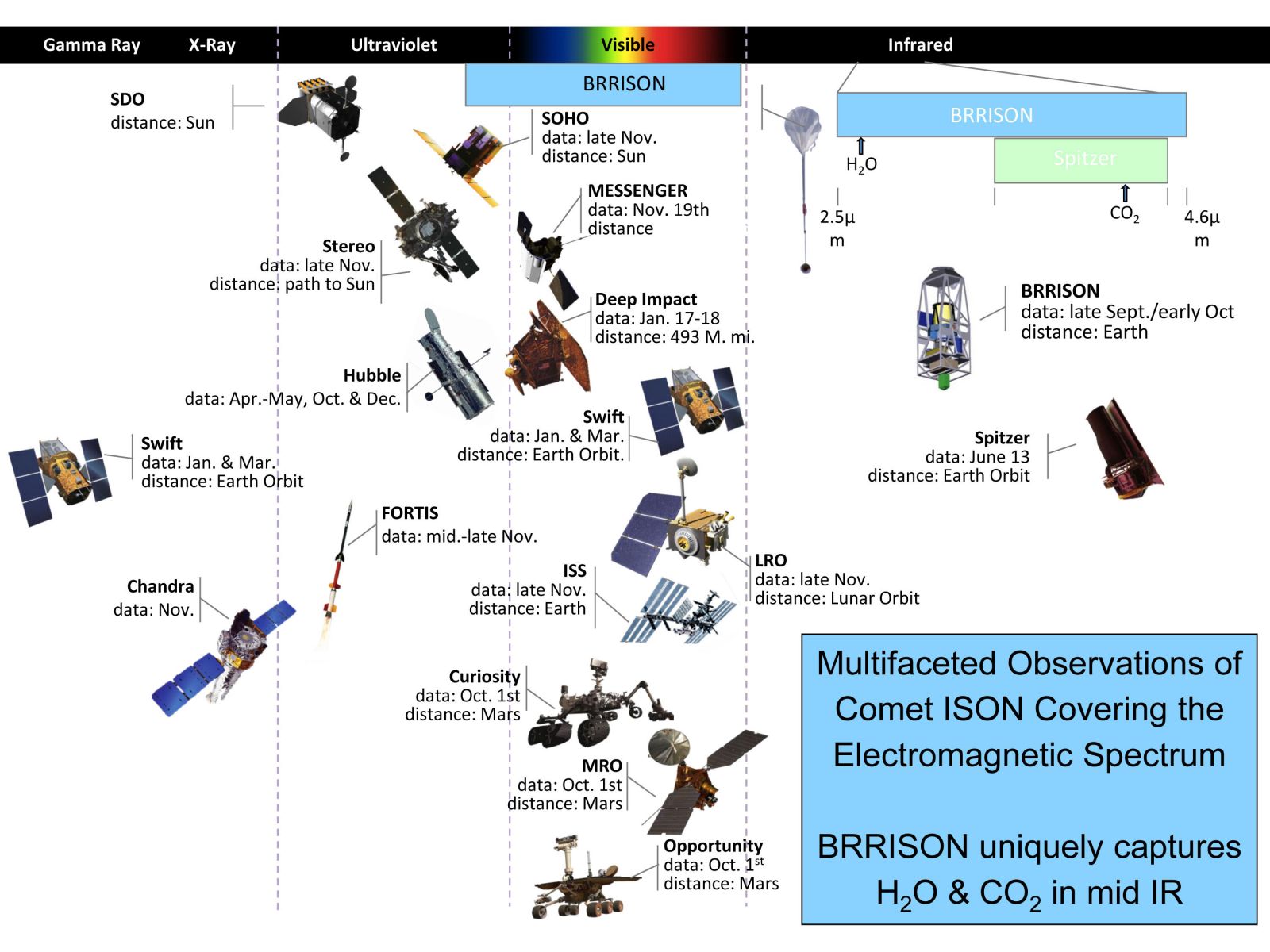
Multifaceted observations of Comet ISON covering the electromagnetic spectrum
In the Gamma and X-Ray spectrum are Swift, Chandra and SDO.
The ultraviolet spectrum is covered by STEREO, Hubble and FORTIS.
The visible spectrum will be covered by a wide-ranging fleet of spacecraft ranging from MESSENGER at Mercury to Curiosity at Mars and BRRISON, a balloon that will study the comet from Earth's upper atmosphere. BRRISON uniquely captures H2O & CO2 in mid IR.
Spitzer will also observe the comet in the infrared spectrum.
Credit: NASA
Conclusion – dissection of a comet
No matter how Comet ISON will behave in the coming days and months we now have a range of powerful satellites and a new generation of ground-based observatories which will all make this comet a rare and special treat for astronomers and scientific community. The comet will be dissected across the electromagnetic spectrum, from radio to X-rays. “There's a lot of potential in studying ISON,” – Karen Meech of the Institute for Astronomy in Hawaii. “We'll have a huge amount of data to learn from.”
Long live ISON – we are waiting for you on the other side of the Sun.
Resources.
- ISON Campaign – http://www.isoncampaign.org/
- Hubble's ISON blog – http://hubblesite.org/hubble_discoveries/comet_ison
- SpaceWeather's Image Gallery – http://spaceweathergallery.com/index.html
- SDO views Comet ISON – http://cometison.gsfc.nasa.gov/
- The Sky Live – ISON Tracker – http://theskylive.com/ison-tracker
- NASA's Comet ISON toolkit – http://solarsystem.nasa.gov/smallworlds/cometison.cfm
Featured image: Comet ISON on November 15, 2013. (Credit: Damian Peach)

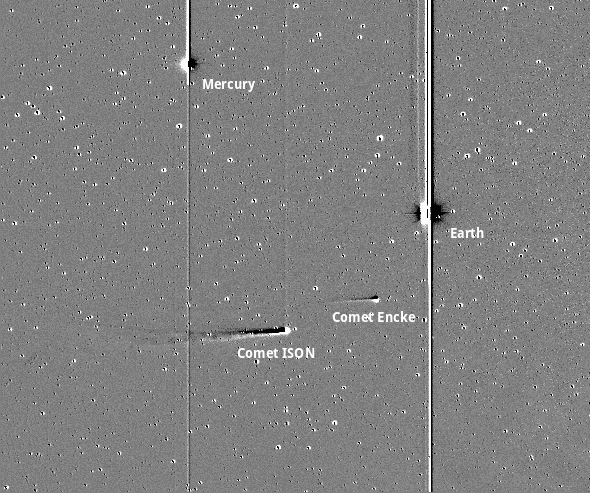
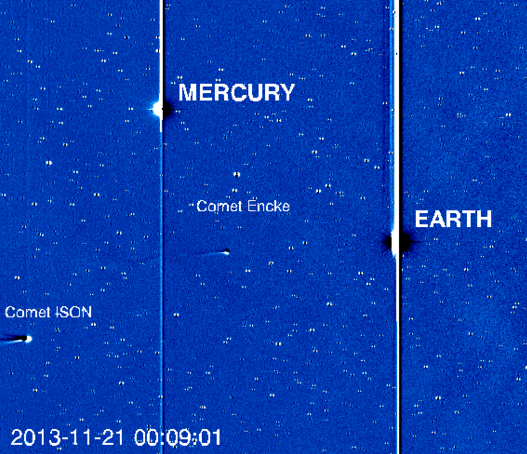
Commenting rules and guidelines
We value the thoughts and opinions of our readers and welcome healthy discussions on our website. In order to maintain a respectful and positive community, we ask that all commenters follow these rules:
We reserve the right to remove any comments that violate these rules. By commenting on our website, you agree to abide by these guidelines. Thank you for helping to create a positive and welcoming environment for all.